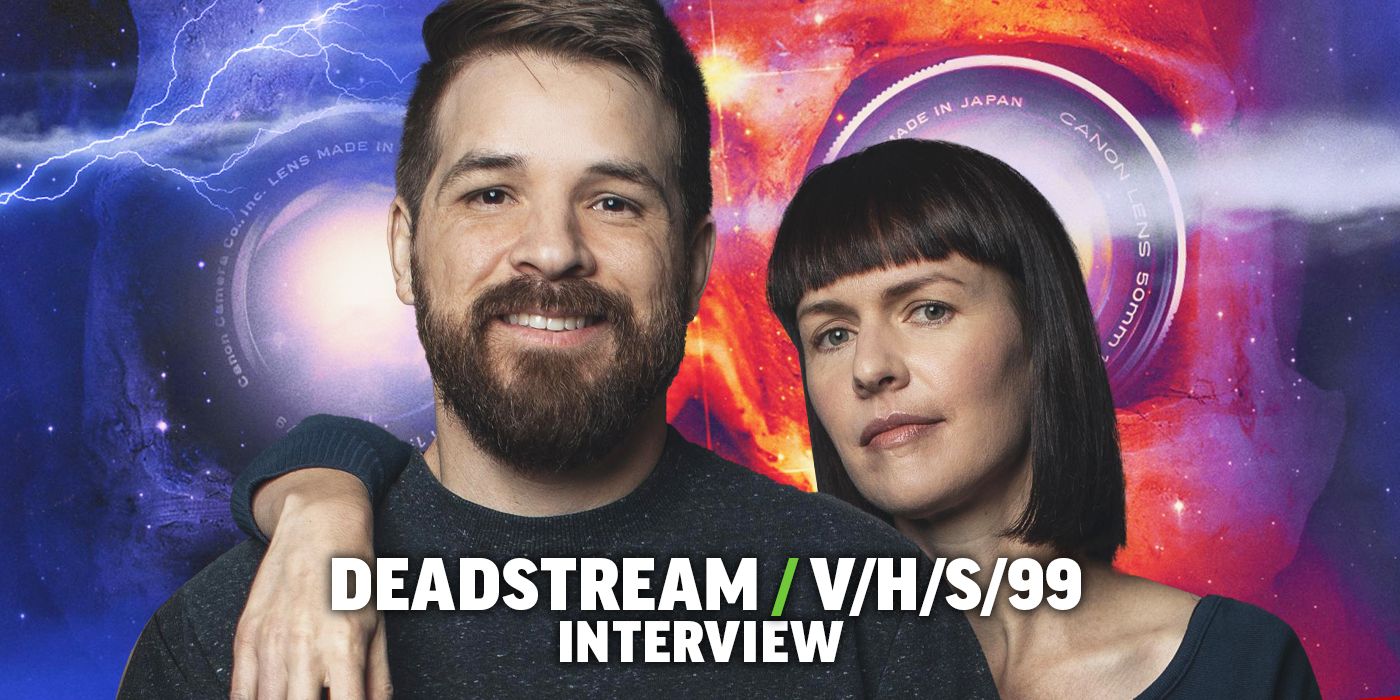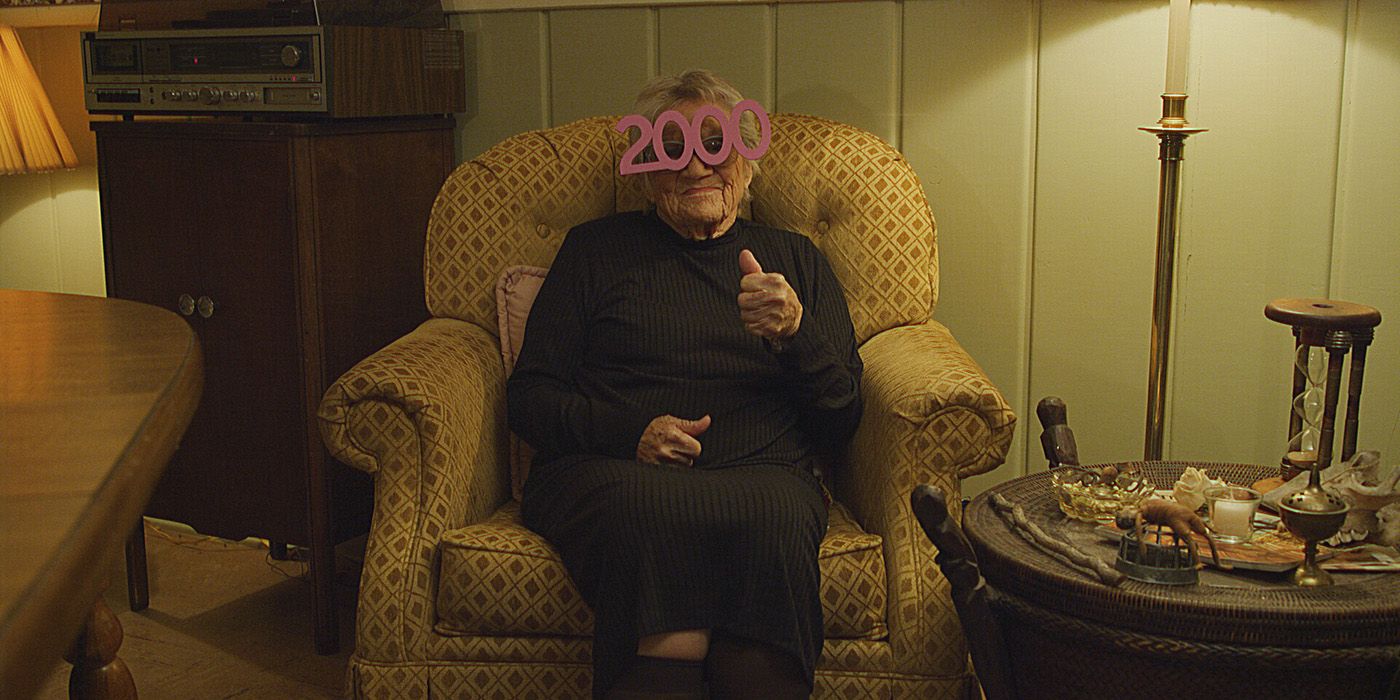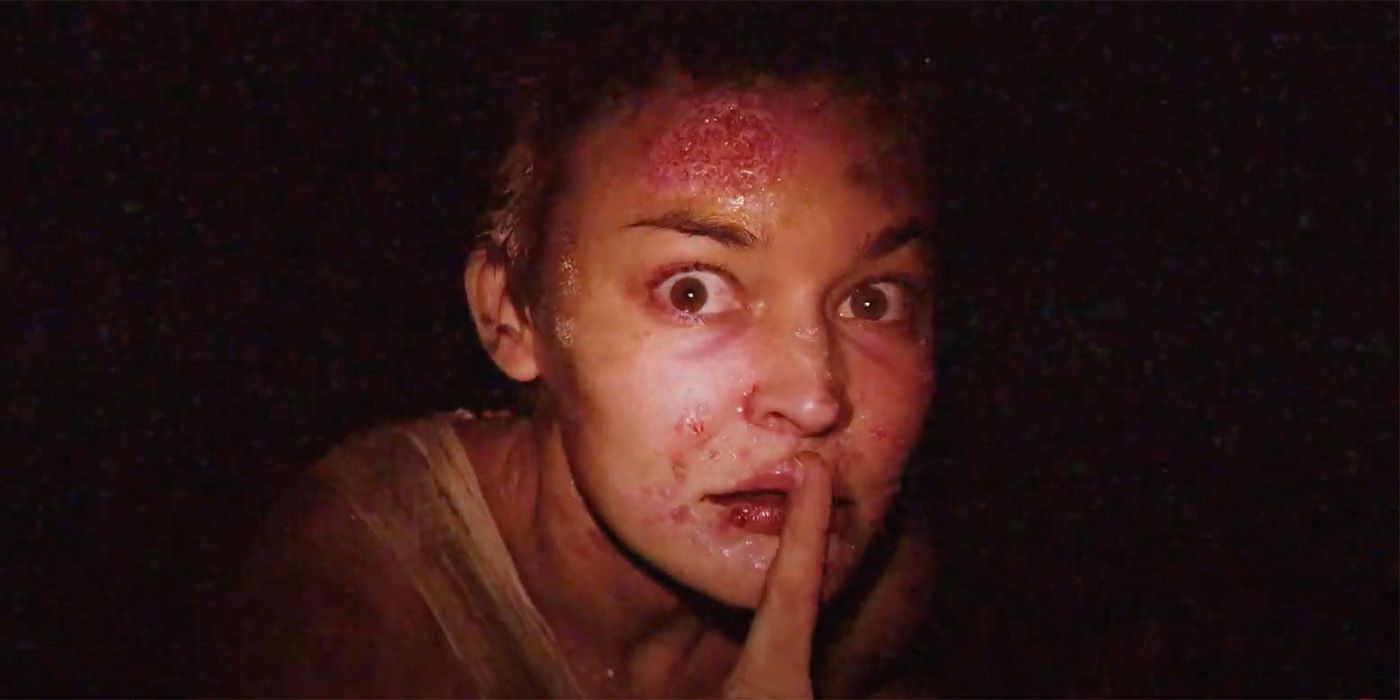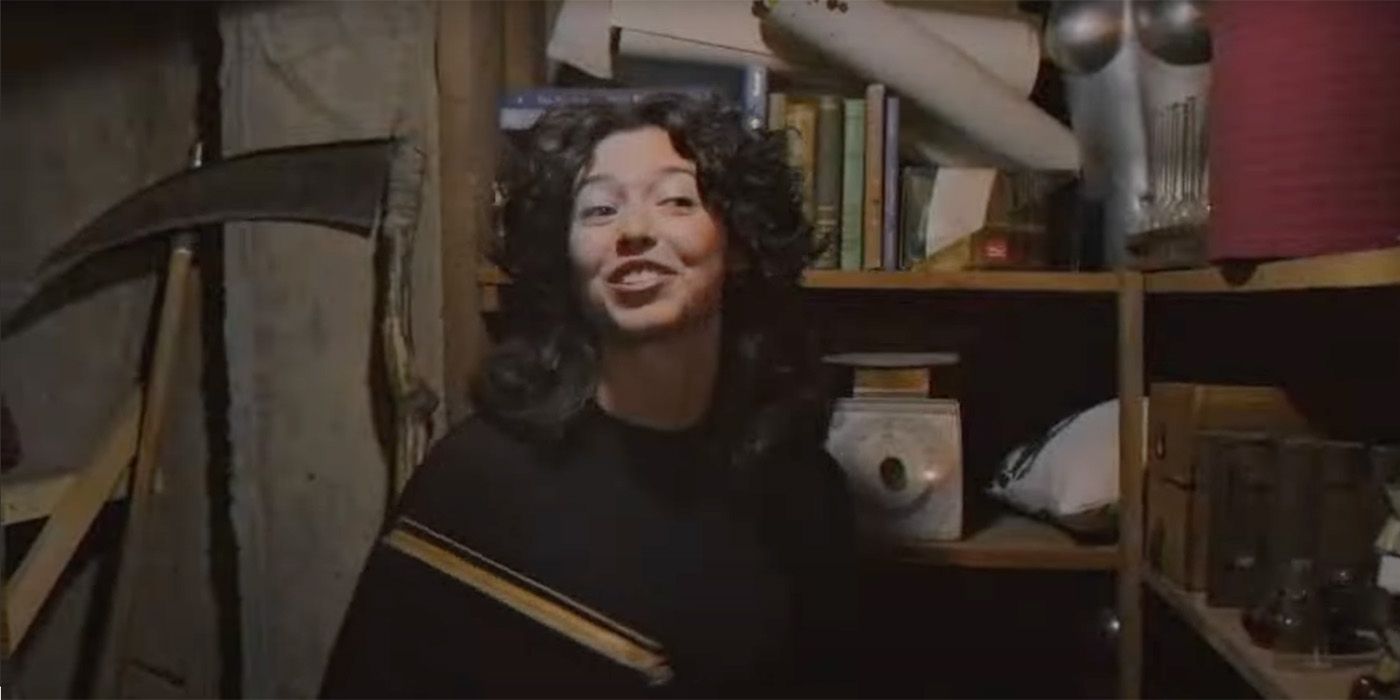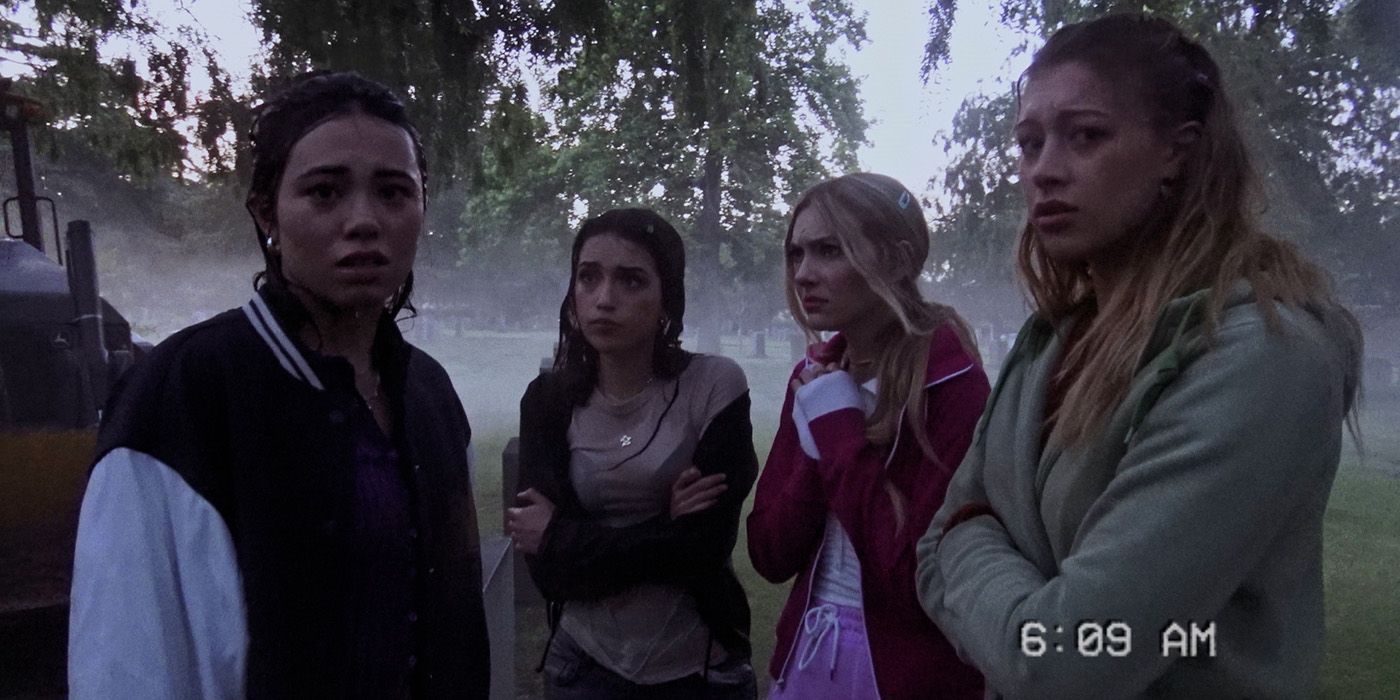There’s nothing more spectacular than watching a movie no one is talking about and finding out it’s one of the best releases of the year. That’s exactly the case with Deadstream, an innovative found-footage horror feature developed by Vanessa & Joseph Winter, who wrote, directed, produced, and edited the movie. And in the same month that Deadstream got to Shudder, Vanessa and Joseph Winter are also back for V/H/S/99, as they’ve developed what’s arguably the best segment of a great horror anthology, To Hell and Back. So, of course, we couldn’t miss the opportunity of talking with the creative duo and learning more about their successful filmmaking process.
For those who still didn’t get to watch Deadstream on Shudder, the movie mimics a live stream through which an internet celebrity, played by Joseph Winter himself, decides to spend a night in a haunted house to get those juice clicks. Of course, things get out of control really fast, as we are treated with a unique ghost story that will scare you just as much as make you laugh. Similarly, the duo’s segment in V/H/S/99 follows two men literally trapped in hell, with Joseph Winter sharing the leading acting credits with Archelaus Crisanto. They are both amazing movies that push the boundaries of what we can do with found footage and should be on the list of any horror fan.
Both Deadstream and V/H/S/99 are available right now on Shudder. But if you haven’t seen the two movies yet, don’t worry, our interviews with Vanessa & Joseph Winter steer away from big spoilers. So, if you want to learn more about indie filmmaking, how it’s working on the V/H/S franchise, and get some great horror movie recommendations for Halloween, you are safe to check out the interview before you watch Deadstream and V/H/S/99. Don’t forget to turn the lights off.
COLLIDER: So, I would like to start by pointing out some similarities between To Hell and Back, your segment at V/H/S/99, and Deadstream. They are both horror films, they both have a lot of comedy, Joseph plays the main character in both films, and they are both found footage. Did you work on them together? And if so, how did you manage to make both at the same time?
VANESSA WINTER: V/H/S/99 came after, so Deadstream was completed and premiered at South by Southwest [Film Festival]. And afterward, we were extended the invitation to work on V/H/S/99. So they weren't happening at the same time.
JOSEPH WINTER: Deadstream was actually filmed two and a half years ago now. It was a long time ago. And the post-production took a while, and then the festival circuits. It’s been on a really long tour. So even though it just came out, it actually feels like we made it a long time ago. But the cool thing about going from Deadstream right to V/H/S/99 is we were able to take the same core team over to it. And that gave us some continuity with knowing how to pull off this kind of production. And we were able to use the same kind of camera rig that we had in Deadstream. So it was actually really nice to shoot those almost back to back.
Yeah, what's cool about Deadstream is that it mimics a live stream. So there are no visible cuts, it looks like it happens in real-time. And you took the same approach in To Hell and Back. Why did you decide to use the same approach for both films? What attracts you to found footage?
JOSEPH WINTER: In both cases, the non-editing-like real-time aspect was Vanessa's idea. In both cases, I had a vision that was more of an edited presentation. In Deadstream, it was supposed to be over the course of a whole night, and it was kind of edited to just the parts we needed it to be. But she thought it would be a lot more engaging if the audience was experiencing it in real-time. And she turned out to be right. Once I figured that out, then I was all in with that. Same thing with this V/H/S segment, I was thinking, “Okay, it can only be a few minutes. And if these dudes have to figure out how to get from hell back to Earth in just a few minutes without cutting, that's going to be really difficult to do”. And it was difficult. However, it made it really thrilling in the story as we started to construct like they only have eight minutes. It just kind of increased the stakes to have that ticking time component to it, which I think really helped the pace.
VANESSA WINTER: I think found footage is fun because of all the different possibilities. It gives you a chance to kind of play with people's expectations or maybe give them that feeling that they're more immersed than other film formats because you may feel like you're the person holding the camera or something like that. And so I liked the forward propulsion of real-time for V/H/S/99 because I think there's something about it that works well with our style of comedy that maybe kind of just throws you into it or helps you suspend your disbelief a little bit for all the silliness and craziness that are going to happen. So I just particularly like the energy of it, but I do think it could be done other ways and found footage done other ways is really fun too.
Found footage is really fun, but I was really impressed by both of your movies because putting it together like it was in real-time must have been a huge challenge. Found footage is usually cheaper and easier to make, and horror doesn't have huge budgets to spend, so it's a perfect tool for horror movies. But you've decided to put in some extra effort to glue it all together as if it was real-time and the result is very, very impressive.
JOSEPH WINTER: Thank you!
VANESSA WINTER: Thanks.
And I've also seen that you worked in the art department of short films and that Joseph is a composer. How are these previous experiences in every area of filmmaking reflected in work on Deadstream and V/H/S/99?
JOSEPH WINTER: For me, it's up to this point, and including on both of those productions that you mentioned, they're very small crews, and there's not really any money. With Deadstream, there was a little bit of money. And then with V/H/S/99, same kind of thing. But before that, the short films that we would make were usually no money, or we're talking a couple of hundred dollars, that kind of thing. And inherent to that are small crews and everybody involved wearing multiple hats, particularly us as directors, having also been producers and editing it ourselves. But that actually was such a valuable skill. And all of those ways, having an understanding of how doing the art works, having hung our own wallpaper and things like that in shorts in the past, coming into an almost do it yourself project where people are working for very little or free sometimes, and having an understanding of what it takes to do it and an appreciation of what the crew members are having to do to pull off a feature film with very little resources. And I kind of felt like there was a mutual respect. Because of that, I think people that we worked with got the sense and could tell that we had done this kind of thing before. And we were very appreciative of the scrappiness, the scrappy situation that they were in and putting stuff together. I feel like that just helped the camaraderie of the situation, feeling like we were all on the same team.
VANESSA WINTER: Yeah. That being said, our creature designer and makeup effects team, art department and costume department are very, very professional. And they brought to both of these projects – it was basically the same crew and same team – so much with their passion and their ideas. And I definitely don't want it to seem like we were doing it all. Even though we were wearing multiple hats, we had crew members that we're just so lucky to work with. They're so talented.
JOSEPH WINTER: Yeah, very stellar. I mean, every crew member that we had was by far better at the jobs we have done before on previous films and we were very fortunate in that way.
I was intending to talk about creature design, because the creature design both in Deadstream, and specially To Hell and Back where you got a little bit more creative representing the demons, was spectacular. Do you come up with part of the creature design yourselves? Or do you delegate completely to another crew member? How do you work with your creature design?
VANESSA WINTER: We usually have some ideas. But then Troy Larson, our creature designer, usually takes it to the next level. An example would be in V/H/S/99. We were looking at some old medieval paintings by [Hieronymus] Bosch that have these half-animal, half-people designs. And so we were bringing those to Troy. And I've been given permission to give this spoiler about V/H/S/99: there is a creature in there that's half-woman, half-maggot. And he came up with a name for her: a Wormaid. And it's one of my favorite creatures. That's an example of us bringing a concept to him, but him taking it and then realizing it as an actual monster and bringing his own personality and next levelness to it.
JOSEPH WINTER: The kind of talks that we would have are like: “This is the gag that's in the story”. We reference movies like, in Deadstream, House or Creepshow, and that kind of personality coming through with the character, but this is the function. And then he would come back to us and say: “Anatomically, what if it could do this? Or what if the creature had this?” There is a winged demon – you can't have a hell movie… I mean, people are gonna assume there's a winged demon in the movie. But he was thinking: “What if it was not what you've traditionally seen, but it was part of Hell, where maybe this person's Hell is that their wings are growing out of their tissue, like their spine, their skeletal structure, and every time the wings expanded, it would hurt them?”. And it's awesome. It's so much better that way because he came up with that. And then with Mikaela it is the same kind of thing.
VANESSA WINTER: Mikaela Kester is the makeup effects artist who also designed some of the creatures in Hell.
JOSEPH WINTER: Yeah, and with the makeup is that same thing, we come to her with what we think it should be. And then she just starts going and presenting us with stuff, her own ideas, which make it so much better.
Another thing that I noticed in both Deadstream and To Hell and Back is that you like to use practical effects. So there are a lot of prosthetics, and there is a lot of makeup work. And this gives a unique look to your movies. That is great. It's amazing. Why did you choose to use so many practical effects? Was it budget-related, or was it some sort of preference?
VANESSA WINTER: It just comes from passion. We both love the art of practical effects. And we really admire it and love being a part of it, or watching it happen on set. Well, that's my personal answer. Anyway, it's just passion. I also like the texture that it brings to film, and horror specifically.
JOSEPH WINTER: Well, for me, the first thing when I was four or five, the first aspect of horror that made me want to be a filmmaker or be involved on that side of the camera was watching the making of “Thriller”, where there's a part you can see the zombies after a shoot peeling latex off of their face. And when I was a kid, that was amazing. And then seeing movies evolved to where they started being CG – and it wasn't very good. And it still isn't, oftentimes, when they're thrown in horror movies. It just made me feel like that's not what I signed up for. These aren't the movies I was consuming. It looks way different. It's not scary. And so we've tried to make it a point to bring back fun, practical effects. And it also feels like it's kind of a dying art. It seems to be having a comeback right now, which is great. We will do VFX when needed to tell the story. In V/H/S/99, there were certain blood gags that didn't work. Most of the blood stuff did work, and looks awesome, but there were parts that didn't. We had Justin Martinez, an amazing VFX artist, help us out with some augmented blood stuff. We love that kind of thing, too, and we'll probably continue to use that when it's not practical to go practical.
You're absolutely right. Practical effects look a lot better in general. I feel like V/H/S/99 makes a lot of effort to look real. And yeah, it's a great choice that you use a lot of practical effects.
VANESSA WINTER: Oh, there are some great ones in the other segments.
Oh, this is for sure. V/H/S/99 have amazing creatures. They really stepped up their game last year with V/H/S/94. And this year with V/H/S/99, it's amazing. And about V/H/S/99, how is the work process of making a segment for the V/H/S franchise? Do you get free rein? Do you have a runtime that you must respect? Do you have a theme that you must discuss with someone? Or are you free to do whatever you want?
VANESSA WINTER: At least in our experience, it's very friendly to taking risks, and kind of doing your own thing. I think that kind of the premise of V/H/S is to let the individual voices happen. Even though it's an anthology, when people sign up for a V/H/S movie, they expect each segment to be very different. So there was definitely some collaboration and talking through ideas with the producers, but we were pretty much left up to do what we wanted to do.
JOSEPH WINTER: It was actually pretty incredible and shocking every step of the way. We would say: “This is what we're going to do”. And then we'd be like: “They're going to say ‘No, that's too silly’”. But instead, they’d be: “We love it. Go do it.”. There were a couple of parts where we needed some additional support, so I would call Josh Goldbloom, the producer, and he was really supportive about trying to get us what we needed to realize our true vision of what this Hell segment should be. And the note that we had going in was: come up with a concept that's between 15 and 20 minutes. But then I was having a conversation with Josh later about the edit and what if it's longer than 20 minutes, and he said: “But if it's the best 25 minutes that we've ever seen, then that's fine.”. They just wanted it to be the best version of what it needed to be. There weren't a lot of rules going in, and that was great.
VANESSA WINTER: All the producers on V/H/S are true horror lovers, and I can't imagine a more stellar producer lineup.
JOSEPH WINTER: It was so great.
That sounds really amazing. I'm already excited to see whatever you come up with next. So I have to ask, are you working already on a new short movie or maybe a feature?
JOSEPH WINTER: Nothing that's been greenlit. But we do have multiple projects that we're actively working on hoping to have some news very soon.
Well, I do hope you have news very, very soon. Because both Deadstream and your V/H/S/99 segment are amazing. And I hope to see more of your work soon enough.
JOSEPH WINTER: Thanks so much, Marco.
VANESSA WINTER: Thank you.
Before letting you go, we are still in Halloween month. This is still October. So I would like to ask you. What are your three favorite horror movies?
JOSEPH WINTER: I’ll go first, I have mine. Creepshow, The Gate, and – these are my three – Monster Squad, Silver Bullet, and The Shining.
VANESSA WINTER: You cheated!
It's reasonable.
VANESSA WINTER: I won't say my favorite, but I'll say some recommendations for Halloween month. There's a seventies movie called Let's Scare Jessica to Death, which I think everybody should watch. I'm going to do all seventies movies. Don't Look Now is another favorite of mine. And there's also one that I don't hear talked about as much called Burnt Offerings that I've been thinking a lot about. So those are my three.
JOSEPH WINTER: All three of those have great textures and aesthetics that are totally appropriate for Halloween month.
Perfect. So thank you so much for joining us. Thank you, Vanessa. Thank you, Joseph.
JOSEPH WINTER: Thanks, Marco. Talk to you soon.
VANESSA WINTER: So nice to meet you.
Nice to meet you too. Bye.

